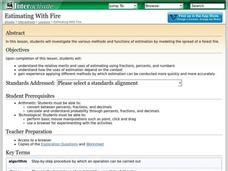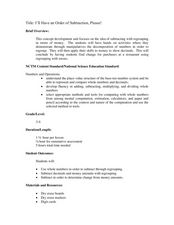Shodor Education Foundation
Estimating With Fire
Watch the damage from a forest fire in this interactive simulation activity that challenges learners to estimate the burn area using different approaches. Learners are given a worksheet to track the different burn patterns and practice...
Collaborative Learning Project
Four in a Row Addition and Subtraction
Scroll down to find four fun addition and subtraction partner game boards, complete with endless opportunities for practice with numbers 0-38. Kids choose numbers from a number box and, depending on the game, either find the sum or the...
Mathematics Assessment Project
Classifying Proportion and Non-Proportion Situations
Proportions, proportions, everywhere. Class members complete an assessment task solving problems involving proportionality. They then complete an activity classifying given situations as proportional or non-proportional.
Teacher's Corner
Hey Batter, Wake Up!
Does jet lag affect a baseball team's performance in games? Read about how a baseball team's chance of winning a game can be affected by traveling over one, two, and three time zones. Readers then respond to five short answer questions...
Shodor Education Foundation
Sequencer
Take the first step into graphing sequences. Learners set the starting number, multiplier, add-on, and the number of steps for a sequence. Using the inputs, the interactive calculates and plots the sequence on the coordinate plane. Users...
Pearson
End of Year Practice Test (Algebra I)
This complete multiple choice and short answer practice end-of-year test for algebra 1 offers a wealth of opportunities for customization. Offer it as a whole, to track progress or prepare the class for the format of the test, or...
Willow Tree
Line Graphs
Some data just doesn't follow a straight path. Learners use line graphs to represent data that changes over time. They use the graphs to analyze the data and make conclusions.
California Education Partners
Linflower Seeds
How does your garden grow? Use proportions to help Tim answer that question. By using their understanding of proportional relationships, pupils determine the number of seeds that will sprout. They create their own linear relationships...
Shodor Education Foundation
Multiple Linear Regression
You'll have no regrets when you use the perfect lesson to teach regression! An interactive resource has individuals manipulate the slope and y-intercept of a line to match a set of data. Learners practice data sets with both positive and...
Kenan Fellows
Least Squares Linear Regression in R
The task? Determine the how effective hospitals are at reducing the rate of hospital-acquired infections. The method? Data analysis! Using an open source software program, individuals use provided data and create scatterplots to look for...
Curated OER
Review For Test On Chapter 5
Young scholars engage in a study of various concepts in relation to preparing for a calculus exam. They sketch and discuss and sketch a variety of functions. The lesson includes an outline of review that should be used by the teacher...
Curated OER
Mixed Fractions Math Bingo
In this math worksheet, students solve the problems that use the game of BINGO in order to improve skills of working with mixed fractions.
Curated OER
Design a House
Students explore the basics of house design and compare examples of architecture from different times and places. The influence of site, materials, function, form and style are probed as their own floor plans are created.
Curated OER
Don't Let Parabolas Throw You
Learners identify relation, function, patterns and range. In this algebra instructional activity, students factor and graph quadratic equations. They use transformation to move the parabola around and make predictions.
Curated OER
I'll Have an Order of Subtraction Please!
Students explore number values by completing consumer math worksheets. In this math functions lesson, students identify the use of a decimal in numbers and the place values that are represented when dealing with money. Students complete...
Curated OER
Algebra 2 - Linear Programming
Young scholars read real world problems, determine the variables, and set up the function using algebraic statements. After entering data into the graphing calculator, they display information in the form of graphs and scatter plots. ...
Curated OER
Intro to Trigonometry
After being introduced to the basic trigonometry functions, learners calculate the height of school landmarks. They experiment with different angles to find the correct height.
Curated OER
Kakuro Puzzle
In this math worksheet, learners solve the number puzzle looking for the missing values. The sheet is intended to be a teacher's guide.
Curated OER
Mr. Payne Word Search Puzzle
In this language arts worksheet, students study 10 words in a word bank, then locate them in a word search puzzle. The words appear to be related to algebra; the meaning of the title is not known. There is one misspelled word in the word...
Curated OER
Exploring the FTC using the TI
Students use the Fundamental Theorem of Calculus to solve problems. In this calculus instructional activity, students use the TI to solve the graphing porting of the problem. They practice graphing functions and discuss their place in...
Curated OER
Integer Magic Squares
In this math worksheet, students find the values along the diagonals using integers to become the sum known as the magic number.
Curated OER
Finding Domain and Range
In this domain worksheet, students study graphs of equations and determine the domain and range of each one. Afterwards, they solve equations to find the domain. There are 15 problems on this one-page worksheet.
Curated OER
Basic Limits
Learners calculate the limits of functions. In this calculus instructional activity, high schoolers find the left and right handed limits of different functions. They use the Ti Navigator to drag the function around as they study limits.
Curated OER
Limits at Infinity
Young mathematicians solve problems involving limits in this calculus lesson. They identify the value of x as the limit approaches positive and negative infinity. Learners study the magnitude as x increases in value.

























